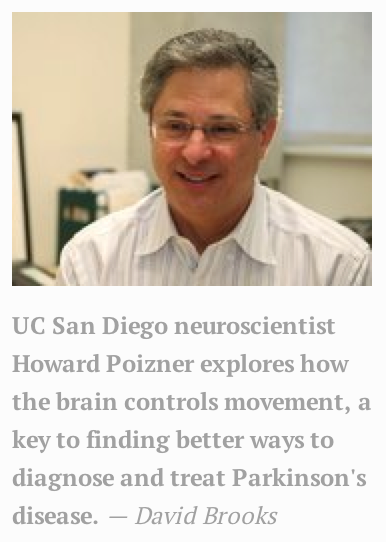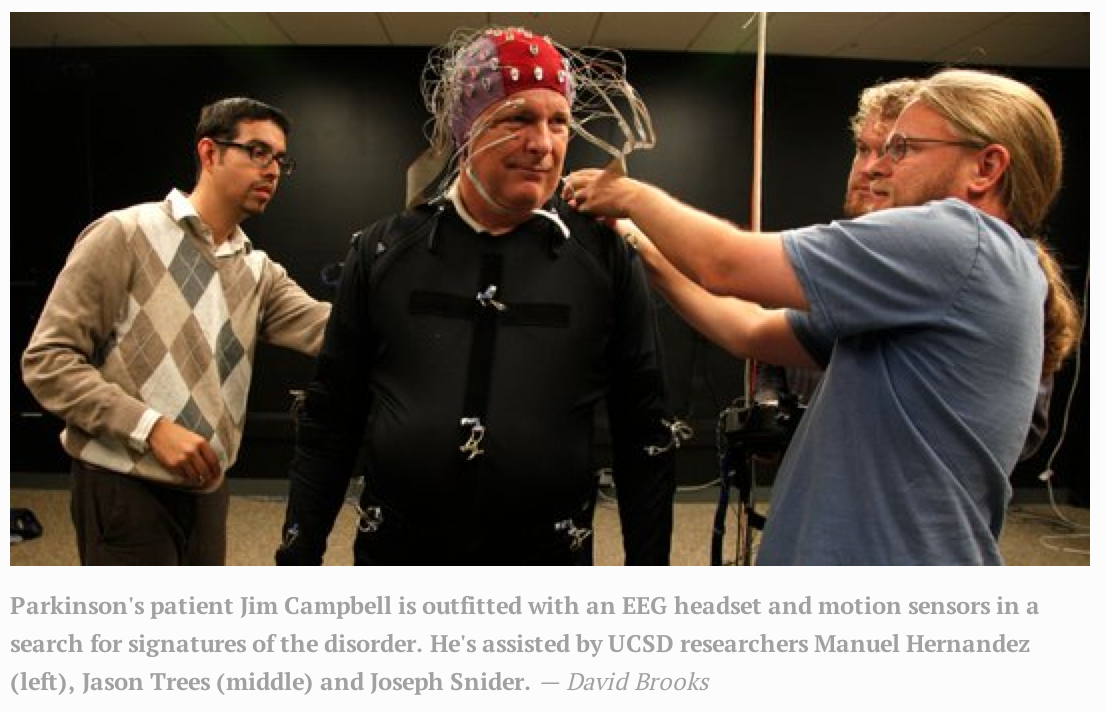Hot on the trail of Parkinson's
Sep 22th, 2013
By Gary Robbins
Michael J. Fox will return full time to network television September 26th, starring in an NBC sitcom that will give many viewers their first long look at Parkinson's disease, a neurodegenerative disorder that can affect a person's speech, movement and balance. Fox, 52, was diagnosed with Parkinson's about 20 years ago. He's since become a leading advocate for expanding research on a disease that afflicts 1 million Americans — including singer Linda Ronstadt, who recently announced that she can no longer sing because of the illness. UC San Diego has a large Parkinson's research program, part of it led by Howard Poizner, a neuroscientist who uses electroencephalography, or EEG, to measure the brain's electrical activity along the scalp. |
|---|
It can be an effective tool for studying how the brain controls movement, work that's critical to finding better ways to diagnose and treat Parkinson's. Poizner recently discussed his work with U-T San Diego, and here is an edited version of that conversation: Q: Astronomers have telescopes that can peer billions of years back in time. Why can't scientists see the short distance through the skull into areas where Parkinson's slowly unfolds? A: We can see into the skull, but we're looking at very weak signals. The signals that we see at the scalp are roughly a million times weaker than an AA battery. And the skull distorts the picture, making it harder for us to see what's going on. We're dealing with complexity, too. There are places in the cortex where you'll find 100,000 neurons making more than 1 trillion connections in an area about the size of the head of a pin. Signaling can occur hundreds of times a second across a vast communications network. |
|
|---|
|
Q: It sounds like science has a small number of tools that give a crude look at what's happening inside the most complicated network known to humans. Is that the case? A: There are tools that allow you to precisely examine what's happening inside the brains of animals. But things are very limited when it comes to looking at the living human brain, and we want to be noninvasive. Yet progress is being made across many areas, from the way we use EEG devices to improvements that are coming with magnetic resonance imaging (MRI). They'll give us a clearer look at brain activity, which we need. We've got to be able to separate abnormalities that are specific to Parkinson's from those that come with related diseases. Q: You personally make heavy use of EEGs to record brain activity. Why? |
|---|
| A: The EEG can be used in conjunction with other tools to help us get a better real-time look at Parkinson's, which is a chronic, progressive movement disorder. The disease can make it difficult for people to stand up, or to move their feet, or make smooth movements. And it can impair their ability to take corrective action, like grabbing a bottle of water that's been knocked over. To look at this, we put motion sensors on a patient's hands, arms, legs and other parts of their body, which helps us analyze the fine details of their movements. At the same time, we're using the EEG headset to map what's happening in their brain. We then can relate their ongoing brain activity to moment-by-moment changes in their movements. Hopefully, we'll be able to extract signatures of brain activity that are characteristic of Parkinson's in its early stages. We really need that. There's no blood test for this disease. |
|
|---|
|
Q: On his new show, Michael J. Fox moves around a lot — and he moves quickly. You're keying in more on movement, and is that a change in what researchers do? A: You raise a very important point. Traditionally, monitoring brain activity has required people to be sitting still or lying down with their heads restrained. This has been done to prevent muscle activity from interfering with the brain recordings. But that's been changing due to advances in hardware and advances in the way EEG signals are analyzed. And we can record these signals wirelessly. We can now record people's brain activity while they're actually moving around or reacting to things that they see while wearing a virtual reality headset. This is critically important; it allows us to study how the brain acts in real-world situations. Q: What kinds of things are you looking at? A: I do basic research into how the brain controls movement, which is closely tied to Parkinson's. The disease affects the circuitry of the brain. It alters the timing and sequence and rhythm of the brain's communication networks. These circuits can get locked in particular rhythms, which makes it harder for people to react to stimuli. |
|---|
Q: Fox is a beloved figure who will be making light of his own struggles with Parkinson's in his sitcom. Is this show likely to teach people a lot about a disease that few understand, or will viewers turn away because it is hard to watch a person with a movement disorder? A: My gut says that people will watch the show. They relate to Michael J. Fox. They know him, in a sense. He's engaging, funny. I think they'll react to the fact that he's finding happiness and hope while living with a devastating disease. He's bringing this message into their homes through TV, and they need to hear that there's hope. We're seeing others — people like Linda Ronstadt — living with Parkinson's. We don't yet know the precise causes of this disease. But there are a lot of excellent therapies that can help a lot of people, and these are exciting times in the world of research. This is a disease that will be cured. It won't happen, say, in the next five years. But it's going to happen. Poizner's research is funded by the National Institutes of Health, the Office of Naval Research and the National Science Foundation. |
|---|



